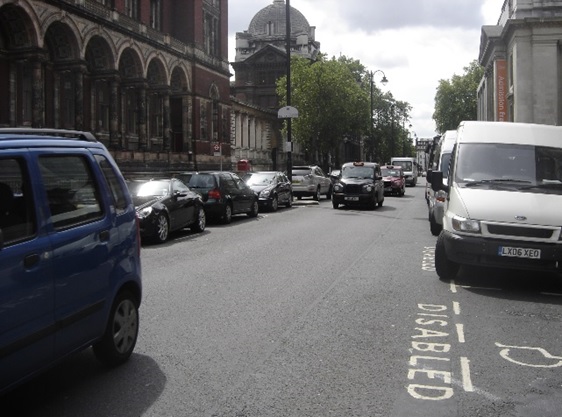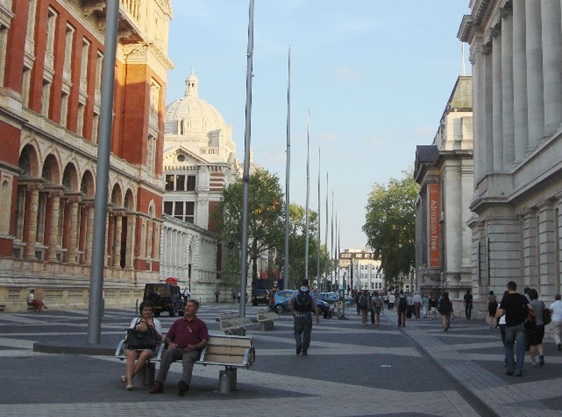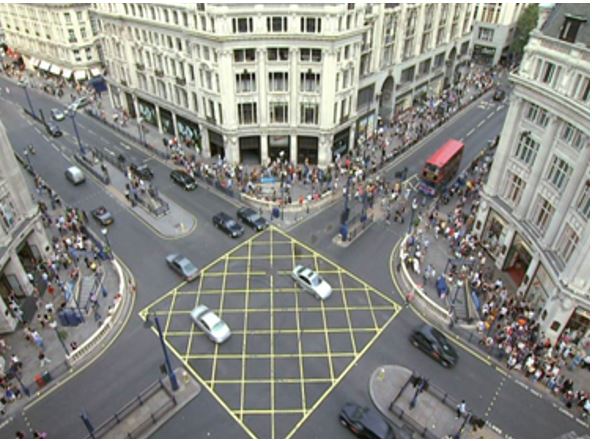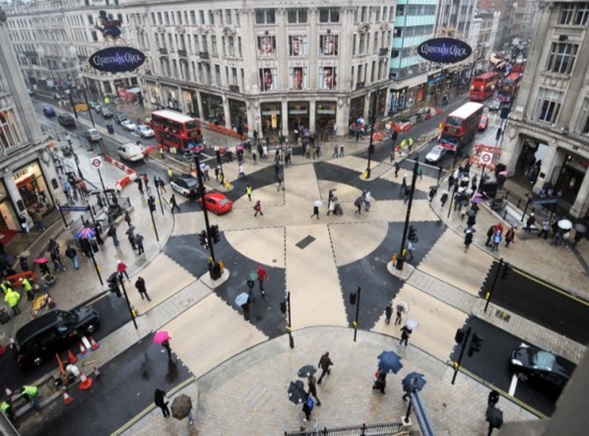Child-friendly neighbourhoods



Integrated street design and shared space, UK

Summary
Recent developments in the field of urban street design have seen the emergence of the concepts of “integrated street design and shared space, which include a range of streetscape treatments aiming at creating a better public realm by asserting the function of streets as places and designing more to a scale aimed at easier pedestrian movement and lower vehicle speeds. This contrasts the traditional approach, according to which pedestrians and traffic are kept apart through street furniture features, or even grade separation.
Context
Traditionally, street design was driven by the concept of segregation of pedestrians and vehicles. The priority was to allow for quicker access and movement of the vehicular traffic by limiting conflicts and human-dependent decisions and by designing streets according to the desire lines of vehicle drivers. As opposed to that, the desire paths of pedestrians were often neglected, with structures such as pedestrian subways, bridges, guardrails and walls restricting their movement. In recent years, however, street design has shifted gradually towards the concept of integration and shared space as a means of creating a better public realm, mainly by asserting the function of streets as places rather than arteries and designing more to a scale aimed at easier pedestrian movement and lower vehicle speeds.
Transformational measures and activities
Integration and space sharing are used as a means of creating a better environment, mainly by introducing single surfaces and pedestrian-friendly features (e.g. seating) while removing elements, such as street furniture, signage, delineation and kerbs. While early examples focused on residential areas, more recent examples are gradually being introduced at several locations worldwide. In the UK, the approach has been formalised into a guidance document, the “Manual for Streets” [1-2], according to which several street layouts have been redesigned, with prominent examples including Exhibition Road [3] and Oxford Circus [4] in London. In the former, a previously conventional dual carriageway road was replaced by a layout featuring: re-allocation of road space from vehicles to pedestrians; unravelling of a pedestrian-unfriendly one-way system; and re-design of pedestrian crossing facilities. In the latter, a previously segregated junction with barriers limiting the overflow of pedestrians onto the street level was “opened up” to allow for diagonal crossing and for pedestrian movement to follow the main desire lines.




Exhibition Road (top) and Oxford Circus (bottom), before (left) and after (right) redevelopment (source: Atkins Intelligent Space)
Results
Results from the implementation of such schemes have shown that benefits can be achieved in terms of road safety (e.g. fewer high-severity traffic conflicts, and so lower accident risk) [5], but also often in terms of mobility efficiency [6]. But most importantly, significant benefits in terms of user behaviour and perceptions can be expected as a result. For instance, research has shown that such interventions increase the confidence of pedestrians in the street and empower them to assert their presence, whereas at the same time, introduce some level of ambiguity for the drivers, and as a result increase their alertness [7-8]. As concerns perceptions, studies have confirmed that pedestrians feel more comfortable in streets redesigned with such interventions compared to their pre-redevelopment layouts [9-10]. So appropriately modified schemes could potentially be relevant for implementation around critical road safety sites, such as schools. Although these schemes have increased empowerment for vulnerable road users in general, one group that perceives disadvantages is the visually impaired. Technological solutions in terms of navigation aids might be considered here.
   |
  |
Challenges, opportunities and transferability
Being permanent interventions requiring the re-design and building of infrastructure, schemes of this kind naturally come with a high implementation cost and effort, especially if the bureaucratic processes of local authorities are considered, which can cause substantial delays. Nevertheless, putting in place dedicated infrastructure to empower pedestrians and improve their safety by calming traffic down can be very beneficial, and very much a long-term goal of any city authority. Budget-permitting, such schemes can be implemented fairly efficiently as part of a city-wide street design strategy.
In depth
- [1] UK Department for Transport (2007), Manual for Streets. Available: https://www.gov.uk/government/publications/manual-for-streets
- [2] Chartered Institute of Highways and Transport (2010). Manual for Streets 2 – Wider application of the principles. Available: https://www.gov.uk/government/publications/manual-for-streets-2
- [3] Royal Borough of Kensington and Chelsea (2019), Exhibition Road website. Available: https://www.rbkc.gov.uk/exhibitionroad/welcome-to-exhibition-road
- [4] Atkins (2019), Oxford Circus Diagonal Crossing project website. Available: https://www.atkinsglobal.com/en-gb/projects/oxford-circus-diagonal-crossing
- [5] Kaparias, I, Bell, MGH, Dong, W, Sastrawinata, A, Singh, A, Wang, X and Mount, B. (2013), Analysis of pedestrian-vehicle traffic conflicts in street designs with elements of shared space, Transportation Research Record, vol. 2393, pp. 21-30. Available: https://doi.org/10.3141/2393-03
- [6] Wang, R. (2017), Before-and-after evaluation of the Level of Service for vehicles and pedestrians in street designs with elements of shared space, MSc dissertation, University of Southampton. Available on request.
- [7] Kaparias, I, Bell, MGH., Biagioli, T, Bellezza, L and Mount, B. (2015), Behavioural analysis of interactions between pedestrians and vehicles in street designs with elements of shared space, Transportation Research Part F: Traffic Psychology and Behaviour, vol. 30, pp. 115-127. Available: https://doi.org/10.1016/j.trf.2015.02.009
- [8] Kaparias, I, Hirani, J, Bell, MGH and Mount, B. (2016), Pedestrian gap acceptance behaviour in street designs with elements of shared space, Transportation Research Record, vol. 2586, pp. 17-27. Available: https://doi.org/10.3141/2586-03
- [9] Mercieca, J., Kaparias, I., Bell. M.G.H and Finch, E. (2010), Integrated street design in high-volume junctions: The case study of London’s Oxford Circus, 1st International Conference on Access Management, Athens, Greece. Available: https://trid.trb.org/view.aspx?id=1137491
- [10] Kaparias, I, Bell, MGH, Miri, A, Chan, C and Mount, B. (2012), Analysing the perceptions of pedestrians and drivers to shared space, Transportation Research Part F: Traffic Psychology and Behaviour, vol. 15, pp. 297-310. Available: https://doi.org/10.1016/j.trf.2012.02.001